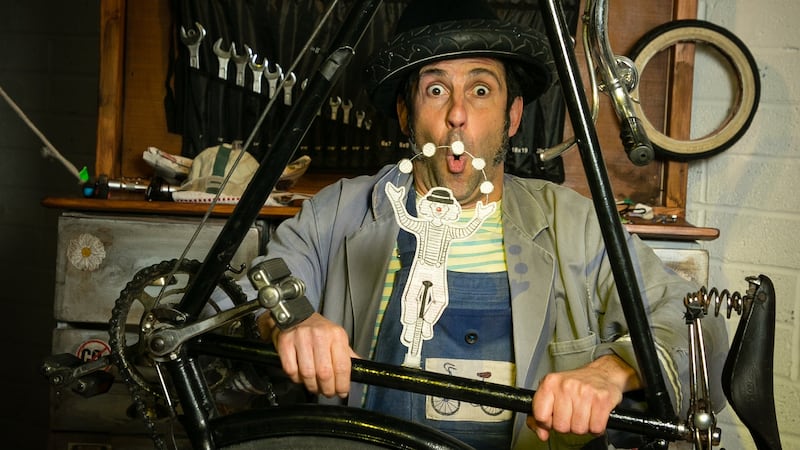Once upon a time, in a small city on the west coast of Ireland, a festival programmer called Patricia Forde had a dream... What would the Galway Arts Festival look like if it was to invite children to join its growing audience? Like a fairy godmother with a magic wand, Forde programmed a series of plays for children alongside the other artistic offerings at the annual festival, and Baboró was born. Baboró International Arts Festival for Children is 25 years old this year and it has become a key part in the fairytale of cultural provision for children in Ireland.
Speaking to me from her home in Co Galway, Forde explains the first impulse for the festival. “I was director of the Galway Arts Festival between 1990 and 1995,” she explains, “and during that time we saw a big change in our audiences, from single people and backpackers to young families, who were looking for stuff for their children to do while they were attending the festival. So we said we would put in a programme for kids to run alongside the main programme, and this was the state of play for a couple of years.
“At the time, a lot of the arts was very dependent on community arts programmes and social employment schemes, and a woman called Jean Parkinson approached us and asked if she could do a study on the viability of a separate festival for children as part of one of these schemes. She came back and said ‘I think this would work’, so we decided to do it.”
There was a lot of collaboration and co-operation from the general arts community in Galway, Forde says, both financial and in kind, and eventually, she says laughing, “like bold children we told everyone, ‘we want to go out on our own,’ and, like they were dealing with teenagers, [people] said, ‘are you sure you can manage it?’ Well, we did, and it was a runaway train. It was brilliant from the start.”
From the first festival in 1996, Baboró marked out its territory providing high-quality artistic work for young audiences. By necessity, Forde says, it began as “an outward-looking festival. Ireland wasn’t a very thoughtful place when it came to children back then. People didn’t give much more thought than [children] needed to be entertained or educated, so [Irish work] was issue-driven rather than aesthetic-driven. It was didactic, educational, because that is really what it was for.”
High-quality
By exposing young audiences and emerging artists to high-quality work from abroad, however, Baboró became a key part in driving a change in attitude around the arts when it came to young people.
“People began to realise that children had a right to be enriched and empowered [by their exposure to culture],” Forde continues. “The Arts Council and [Galway] City Council quickly realised the importance of that, and because what we were doing was for children, people really wanted to help.”
Slowly, with development programmes and mentorships, Irish companies such as Branar – Téatar do Pháistí began to produce work regularly for the festival; Branar premieres a new work, Rothar, at Baboró this year. These days the programme provides a balance of indigenous and international work, with a notable year-by-year increase in the quantity of Irish work on view, and a remarkable enrichment in its sophistication and ambition.

Baboró’s current director Aislinn O’hEocha says Baboró’s role in fostering Irish work is one of the key legacies of the festival’s first 25 years. “There was an unofficial mentoring role there from the beginning,” O’hEocha says, “in terms of encouraging Irish artists to see international work and to develop a network, and that definitely played a role in Irish artists making work for the sector. But in 2015, we formalised some of that through our GROW programme, which was an umbrella term for several strands of artist support.”
This included Pathways to Production, which aimed to help artists bring ideas to full realisation on the stage, and Baboró also offered support for mentoring relationships, as well as a specific programme directed at equality and diversity. The results of this investment in Irish artists is clear. This year sees seven Irish commissions spearhead the anniversary programme – a testament to the commitment Baboró has shown in developing indigenous cultural provision in Ireland.
Excited energy
Brú Theatre is one of the companies which has benefited from Baboró’s support. Brú’s artistic director James Riordan was 11 years old when Baboró started. He was too old to be an audience member at that stage, but he remembers “the excited energy on the streets. Galway is so used to having festivals of music and art, with plenty of tourists across the city, but there was always a shift in energy around Baboró time. There would be lots of colourful posters and performers and a feeling that the city was celebrating its young audiences, and the streets would be full of teachers shepherding big groups of kids into the Town Hall or An Taibhdhearc.”
A decade later, as an emerging theatre artist, Riordan was fortunate enough to encounter “some of the best international work for young people, [and that] set a standard for the work I wanted to make”. He remembers in particular Bob Théâtre’s Nosferatu in 2018. “I found it really inspiring. I went two days in a row and still think about how they created a clever, surprising and captivating universe with just lightbulbs and a table. Watching quality international work,” he continues, “educates your palate as an artist, [and that is] important in finding your own voice and developing your practice. Theatre for young people is so varied, and seeing multi-disciplinary, virtuosic work for younger audiences is needed in [terms of] finding new inspirations and engaging with new forms and points of view.”
In 2018, Brú also made its first show for Baboró, a site-specific piece of mask theatre that engaged with local fishing history, and a version of a piece performed earlier that year at the Galway Arts Festival, reimagined for a young audience. The following year, Brú was selected to be part of Pathways to Production, and Riordan worked with Canadian company Mammalian Diving Reflex, creating a new piece of work as part of Galway 2020. Despite Covid, Riordan and his collaborator Darren O’Donnell managed to engage with primary school audiences to create a lockdown olympics. This year, they have been commissioned to create an original work for children, The Libravian, a physical comedy celebrating Irish picturebooks – in the site-engaged environs of bookshops and libraries in the city and county.
Awareness
Another key development of the last 25 years is the increasing role that young audiences themselves have in shaping Baboró. As O’hEocha explains: “When the festival was founded, the UN Convention on the Rights of the Child had been ratified just a few years before, and there was not really that same awareness as we have now about the importance of culture and play in the lives of children.” O’hEocha believes that the work of Baboró has “played an important role in reminding adults that children have a right to access and participate in the arts, whether that’s reading, drawing, going to the theatre, whatever”.
Increasingly, the organisers have tried to represent the voice of the child within the festival’s programme too. Baboró’s artist-in-residence Maisie Lee has created an audio documentary, Don’t Forget to Wash Your Hands, which records the voices of over 100 children from Galway city and county and their experiences during the pandemic. The festival will also pilot a young critics’ programme, “to allow children to engage in a more strategic way with the art and the organisation”.
What their engagement comes down to at its most basic level, however, is the empowering effect that art can have upon young people. As Forde says, “To watch a giddy bunch of five- or six-year-olds squealing and jumping around in their seats become absolutely gripped by what they see... it is incredible. We need to recognise how much the arts encourages them from an early age to think outside the box, to think about diversity, to empathise, to imagine, to be delighted and enraptured in a way that they feel in their bodies.
“To think that we would deprive them of that.”
Baboró International Arts Festival for Children runs from October 4-17. The Libravian runs from October 11-15




















